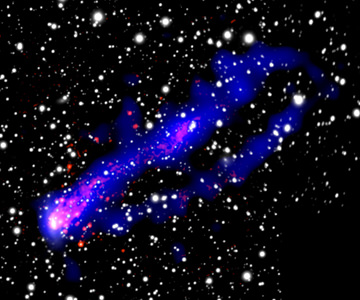[/caption]
Stars forming outside a galaxy? That’s what a new observation with the Chandra X-ray Observatory appears to show. “This system is really crazy because where we’re seeing the star formation is well away from any galaxy,” said Megan from Michgan State University. “Star formation happens primarily in the disks of galaxies. What we’re seeing here is very unexpected.”
The image shows two distinct long tails of gas that are more than 200,000 light years in length and extends well outside any galaxy. The gas tails are located in the southern hemisphere near a constellation called Triangulum Australe, in a giant cluster of galaxies called Abell 3627. It is associated with a galaxy known as ESO 137-001 which is about 219 million light years from our own Milky Way Galaxy.
While a similar type of gas tail are places where stars form, usually this happens within the confines of a galaxy.
“The double tail is very cool – that is, interesting – and ridiculously hard to explain,” said Donahue. “It could be two different sources of gas or something to do with magnetic fields. We just don’t know.”
This gas tail was originally spotted by astronomers three years ago using a multitude of telescopes, including NASA’s Chandra X-ray Observatory and the Southern Astrophysical Research telescope in Chile. The new observations show a second tail, and a fellow galaxy, ESO 137-002, that also has a tail of hot X-ray-emitting gas.
How these newly formed stars came to be in this particular place remains a mystery as well. Astronomers theorize this gas tail might have “pulled” star-making material from nearby gases, creating what some have called “orphan stars.”
“This system continues to surprise us as we get better observations of it,” Donahue said.
Donahue was part of an international team of astronomers who published a paper on the twin tails in Astrophysical Journal.
Paper: Spectacular X-Ray Tails and Intracluster Star Formation
source: MSU


“The double tail is very cool – that is, interesting – and ridiculously hard to explain,” said Donahue. “It could be two different sources of gas or something to do with magnetic fields. We just don’t know.”
In the paper, the authors speculate the twin tails may come from molecular gas stripped from the galaxy’s two major spiral arms. A cartoon diagram of this is on pg. 962 (Fig 16). They lay out a pretty convincing case for it on the same page.
Btw, some really great images of both tailed galaxies in the paper. Worth a peek, if just for the pix.